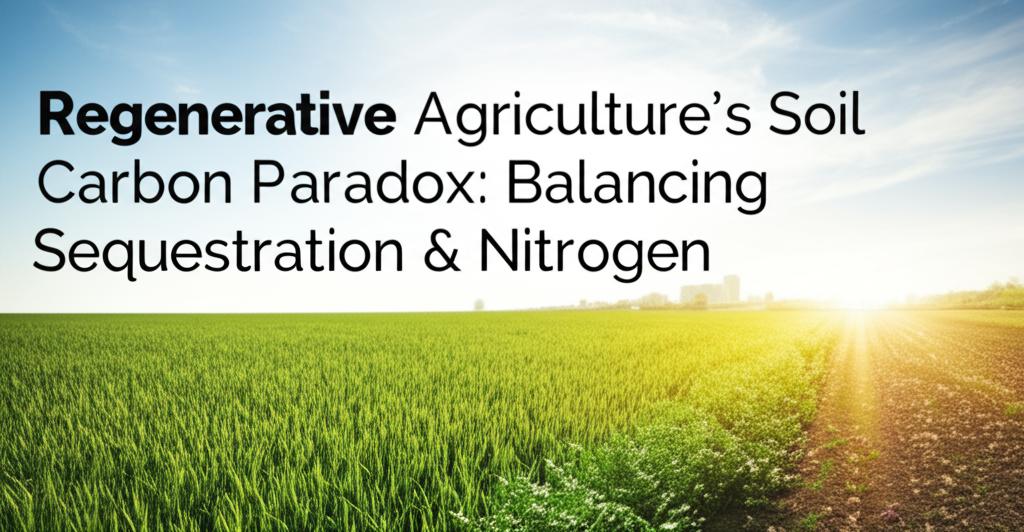Regenerative agriculture is creating a significant buzz for its potential to heal our soils and combat climate change. At its heart is the ambition to draw down atmospheric carbon and store it in the earth. However, this promise isn't without its complexities, particularly when it comes to another crucial element for life: nitrogen.
The core idea of regenerative agriculture is to enhance soil health using practices like no-till farming, cover cropping, diverse crop rotations, and integrating livestock. These methods are designed to boost soil organic matter, which is rich in carbon. Healthy soils, teeming with microbial life, can act like a sponge, soaking up carbon dioxide from the atmosphere. This carbon sequestration is a win for the climate and for farm resilience, as carbon-rich soils hold water better and are more fertile.
However, building soil carbon is not just a matter of adding organic material. For carbon to be stored stably in the soil, it needs to be incorporated into microbial biomass and then into more stable soil organic matter. This process requires nitrogen – roughly one tonne of nitrogen for every 12 tonnes of carbon sequestered, in addition to the nitrogen crops need to grow. This is where the paradox emerges.
Many regenerative practices aim to reduce or eliminate synthetic nitrogen fertilizers due to their significant greenhouse gas footprint and potential to pollute waterways. While this is environmentally commendable, it can create a challenge: if there isn't enough available nitrogen in the system, the ability of the soil to sequester large amounts of carbon can be limited. Plant growth, the very engine that pulls carbon from the air, also relies heavily on nitrogen.
Recent research highlights this delicate balancing act. A May 2025 study from Cornell University using computer modeling found that many regenerative farming practices aimed at building soil organic carbon might actually reduce crop yields in some situations. The study suggests that practices to improve soil health can benefit either greenhouse gas mitigation or crop yields, but rarely both simultaneously on a global scale. This underscores the trade-offs that can exist. For instance, grass cover crops combined with no-tilling showed the highest potential for limiting greenhouse gases but were the worst for crop yields in the model.
Another consideration is the form and stability of the sequestered carbon. Research published in early 2025 indicated that while labile (less stable) carbon stocks increased significantly under regenerative management over seven years, more stable, recalcitrant carbon stocks didn't see significant changes in that timeframe. However, the study also highlighted that stable soil aggregates, encouraged by regenerative practices, can physically protect this labile carbon, contributing to overall sequestration.
So, how do we navigate this paradox? The key lies in smart, integrated approaches. Strategies include:
- Smarter Nitrogen Management: This doesn't necessarily mean a complete abandonment of nitrogen inputs, but rather a shift towards more efficient and ecologically sound sources. This could involve the strategic use of legume cover crops that fix atmospheric nitrogen, optimised manure and compost application, and precision agriculture techniques to apply nutrients exactly when and where they are needed. Some companies are developing innovative sensor technology to enable precise nitrogen application, potentially reducing nitrous oxide emissions (a potent greenhouse gas) without sacrificing yield.
- Focusing on Nutrient Cycling: Regenerative practices inherently aim to improve natural nutrient cycling. By fostering a healthy soil microbiome, more nutrients, including nitrogen, can be made available to plants from organic matter decomposition.
- Diversified Cropping Systems: Including a variety of crops, especially deep-rooted ones and perennials, can enhance soil carbon inputs at different depths and improve nutrient utilization. Agroforestry and silvopasture, which integrate trees with crops and/or livestock, are also promising avenues for both carbon sequestration and biodiversity.
- Understanding Local Context: The effectiveness of different regenerative practices can vary significantly based on soil type, climate, and farming systems. What works in one region might not be optimal in another. Context-specific management plans are crucial.
- Long-Term Perspective: The benefits of regenerative agriculture, including stable carbon sequestration and potentially maintained or even improved yields with reduced inputs, often take time to fully materialize.
While some critics point out that the climate mitigation potential of soil carbon sequestration through regenerative agriculture might be overstated or that some practices could lead to trade-offs like increased pesticide use with no-till in certain scenarios, the drive to improve soil health remains a cornerstone of sustainable farming.
The journey of regenerative agriculture is one of continuous learning and adaptation. The "Soil Carbon Paradox" isn't a roadblock but a crucial area of ongoing research and innovation. By deepening our understanding of the intricate dance between carbon and nitrogen in our soils, we can refine regenerative systems to truly deliver on their promise of a more sustainable and resilient agricultural future. The global regenerative agriculture market is projected for significant growth, indicating a strong belief in its potential. The focus remains on building resilient ecosystems from the ground up.

